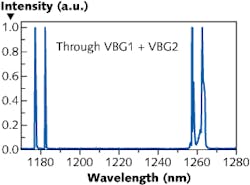Quantum-dot laser produces multiple wavelengths for terahertz generation
A single quantum-dot (QD) laser diode developed by a group at the University of Dundee (Dundee, Scotland) generates stable dual and/or multiple longitudinal modes in the near-infrared. The device has potential for production of terahertz radiation via optical difference-frequency generation.
Temperature-stabilized at 20°C, the laser diode is situated in an external-cavity setup containing two volume Bragg gratings (VBGs): one that selectively returns 1177 ±0.5 nm and 1182 ±0.5 nm wavelengths, and the other that selectively returns 1257 ±0.5 nm and 1262 ±0.5 nm wavelengths. The glass VBGs have an efficiency of about 15% and grating tilts of 1° to prevent backreflections. The difference frequencies for the two gratings are 0.946 ±0.019 THz and 1.078 ±0.021 THz, respectively.
When driven at a current of 70 mA, the laser emitted from the ground state (GS; matching VBG2); at 210 mA, excited-state (ES; matching VBG1) emission dominated the output. Intermediate currents produced a mix of GS and ES emission. Because each VBG is multiplexed (containing two gratings), a total of four wavelengths can be produced by the laser, with the relative output of each of two pairs adjustable by varying the current (the figure shows the output for a 150 mA current). In addition to photomixing for terahertz generation (and potentially two-color terahertz imaging), the laser is useful for spectroscopy. Contact Ross Leyman at [email protected].

John Wallace | Senior Technical Editor (1998-2022)
John Wallace was with Laser Focus World for nearly 25 years, retiring in late June 2022. He obtained a bachelor's degree in mechanical engineering and physics at Rutgers University and a master's in optical engineering at the University of Rochester. Before becoming an editor, John worked as an engineer at RCA, Exxon, Eastman Kodak, and GCA Corporation.
